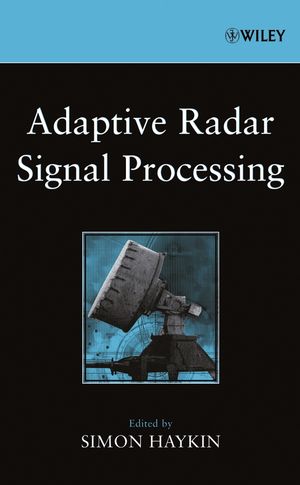Adaptive Radar Signal ProcessingISBN: 978-0-471-73582-3
Hardcover
248 pages
November 2006
 This is a Print-on-Demand title. It will be printed specifically to fill your order. Please allow an additional 15-20 days delivery time. The book is not returnable.
|
||||||
Preface xi
Contributors List xiii
1. Introduction 1
Simon Haykin
Experimental Radar Facilities 2
Organization of the Book 5
Part I Radar Spectral Analysis
2. Angle-of-Arrival Estimation in the Presence of Multipath 11
Anastasios Drosopoulos and Simon Haykin
2.1 Introduction 11
2.2 The Low-Angle Tracking Radar Problem 13
2.3 Spectrum Estimation Background 14
2.3.1 The Fundamental Equation of Spectrum Estimation 17
2.4 Thomson’s Multi-Taper Method 18
2.4.1 Prolate Spheroidal Wavefunctions and Sequences 19
2.5 Test Dataset and a Comparison of Some Popular Spectrum Estimation Procedures 23
2.5.1 Classical Spectrum Estimation 26
2.5.2 MUSIC and MFBLP 27
2.6 Multi-taper Spectrum Estimation 28
2.6.1 The Adaptive Spectrum 28
2.6.2 The Composite Spectrum 32
2.6.3 Computing the Crude, Adaptive, and Composite Spectra 33
2.7 F-Test for the Line Components 35
2.7.1 Brief Outline of the F-Test 35
2.7.2 The Point Regression Single-Line F-Test 37
2.7.3 The Integral Regression Single-Line F-Test 39
2.7.4 The Point Regression Double-Line F-Test 42
2.7.5 The Integral Regression Double-Line F-Test 46
2.7.6 Line Component Extraction 47
2.7.7 Prewhitening 54
2.7.8 Multiple Snapshots 57
2.7.9 Multiple Snapshot, Single-Line, Point-Regression F-Tests 57
2.7.10 Multiple-Snapshot, Double-Line Point-Regression F-Tests 59
2.8 Experimental Data Description for a Low-Angle Tracking Radar Study 60
2.9 Angle-of-Arrival (AOA) Estimation 63
2.10 Diffuse Multipath Spectrum Estimation 78
2.11 Discussion 85
References 88
3. Time–Frequency Analysis of Sea Clutter 91
David J. Thomson and Simon Haykin
3.1 Introduction 91
3.2 An Overview of Nonstationary Behavior and Time–Frequency Analysis 92
3.3 Theoretical Background on Nonstationarity 94
3.3.1 Multi-taper Estimates 97
3.3.2 Spectrum Estimation as an Inverse Problem 98
3.4 High-Resolution Multi-taper Spectrograms 99
3.4.1 Nonstationary Quadratic-Inverse Theory 101
3.4.2 Multi-taper Estimates of the Loève Spectrum 103
3.5 Spectrum Analysis of Radar Signals 104
3.6 Discussion 111
3.6.1 Target Detection Rooted in Learning 112
References 113
Part II Dynamic Models
4. Dynamics of Sea Clutter 119
Simon Haykin, Rembrandt Bakker, and Brian Currie
4.1 Introduction 119
4.2 Statistical Nature of Sea Clutter: Classical Approach 123
4.2.1 Background 123
4.2.2 Current Models 126
4.3 Is There a Radar Clutter Attractor? 130
4.3.1 Nonlinear Dynamics 130
4.3.2 Chaotic Invariants 132
4.3.3 Inconclusive Experimental Results on the Chaotic Invariants of Sea Clutter 133
4.3.4 Dynamic Reconstruction 134
4.3.5 Chaos, a Self-Fulfi lling Prophecy? 137
4.4 Hybrid AM/FM Model of Sea Clutter 139
4.4.1 Radar Return Plots 139
4.4.2 Rayleigh Fading 139
4.4.3 Time-Doppler Spectra 142
4.4.4 Evidence for Amplitude Modulation, Frequency Modulation, and More 144
4.4.5 Modeling Sea Clutter as a Nonstationary Complex Autoregressive Process 146
4.5 Discussion 150
4.5.1 Nonlinear Dynamics of Sea Clutter 150
4.5.2 Autoregressive Modeling of Sea Clutter 150
4.5.3 State-Space Theory 151
4.5.4 Nonlinear Dynamical Approach Versus Classical Statistical Approach 152
4.5.5 Stochastic Chaos 153
References 155
Appendix A Specifications of the Three Sea-Clutter Sets Used in This Chapter 157
5. Sea-Clutter Nonstationarity: The Influence of Long Waves 159
Maria Greco and Fulvio Gini
5.1 Introduction 159
5.2 Radar and Data Description 163
5.3 Statistical Data Analyses 164
5.4 Modulation of Long Waves: Hybrid AM/FM Model 169
5.5 Nonstationary AR Model 179
5.6 Parametric Analysis of Texture Process 181
5.7 Discussion 188
5.7.1 Autoregressive Modeling of Sea Clutter 189
5.7.2 Cyclostationarity of Sea Clutter 189
References 189
6. Two New Strategies for Target Detection in Sea Clutter 193
Rembrandt Bakker, Brian Currie, and Simon Haykin
6.1 Introduction 193
6.2 Bayesian Direct Filtering Procedure 195
6.2.1 Single-Target Scenario 195
6.2.2 Conditioning on Past and Future Measurements 196
6.3 Operational Details 197
6.3.1 Experimental Data 197
6.3.2 Statistics of Sea Clutter 197
6.3.3 Statistics of Target Returns 199
6.3.4 Motion Model of the Target 200
6.4 Experimental Results on the Bayesian Direct Filter 200
6.5 Additional Notes on the Bayesian Direct Filter 204
6.6 Correlation Anomally Detection Strategy 205
6.7 Experimental Comparison of the Bayesian Direct Filter and Correlation Anomaly Receiver 206
6.7.1 Target-to-Interference Ratio 207
6.7.2 Receiver Comparison 207
6.8 Discussion 217
6.8.1 Further Research 218
References 219
Index 221



